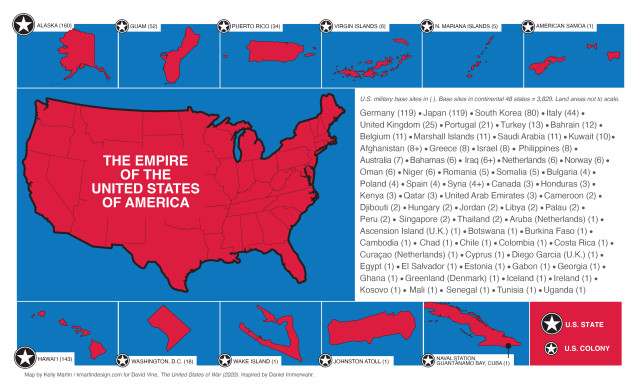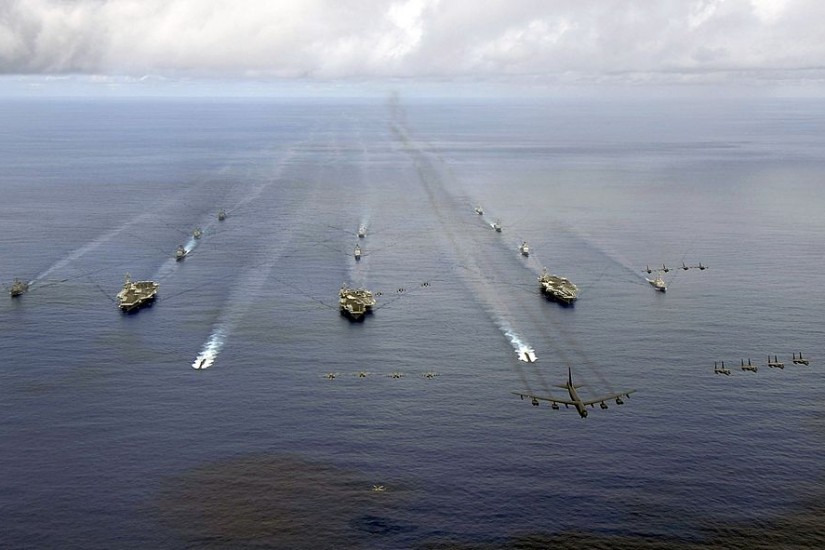The people of Puerto Rico, the U.S. Virgin Islands and Guam, as well as those in the little-mentioned Commonwealth of the Northern Mariana Islands and American Samoa, are all too accustomed to being forgotten except in times of crisis. But being forgotten is not the worst of their problems. They are trapped in a state of third-class citizenship, unable to access full democratic rights because politicians have long favored the military’s freedom of operation over protecting the freedoms of certain U.S. citizens.

Empire of the United States of America. Map by Kelly Martin for David Vine.
Residents of the American territories are ruled from the nation’s capital — a city whose people themselves are second-class citizens lacking representation in Congress — but barred from voting in presidential elections, denied Senate representation and limited to electing a nonvoting member of the House of Representatives. (People born in American Samoa actually have fourth-class citizenship because they don’t get U.S. citizenship automatically at birth.)
Which raises a pressing question: Why, in 2017, decades after the civil rights and decolonization eras, does the United States still have colonies and citizens who lack full democratic rights by law?
The answer is largely simple, but troubling: Because the desires and power of the United States military have overwhelmed the desires and rights of colonized peoples.
The tangled history of the military and citizenship in these colonies played out most clearly in Guam, which, along with Puerto Rico, the Philippines and uninhabited Wake Island, became a U.S. colony as a result of 1898’s war with Spain.
After the Spanish-American War, U.S. officials proudly referred to their new possessions as colonies. The Navy designated all of Guam a U.S. naval station. Technically, the island was one large military base: Naval officers served as governors and generally ran Guam like a ship. In a pattern that has mostly continued to this day, the rights of the people of Guam came second to the military’s.
In a series of cases, the Supreme Court upheld the colonized status of Guam’s indigenous Chamorros, whose ancestors had lived there for almost 4,000 years. The court ruled that as “alien races,” Guam’s people (and Puerto Ricans and Filipinos) were entitled to neither U.S. citizenship nor full constitutional rights.
The Navy controlled Guam until World War II, when it became one of the few parts of the United States occupied by Japanese troops. After brutally suffering at the hands of the Japanese for 32 months, Chamorros expected their suffering and bravery to be rewarded with citizenship and self-rule, if not statehood.
Military officials thought otherwise. They wanted direct military — not civilian — control over as many islands in the Pacific as possible. At their urging, the government held onto Guam and the other colonies as what euphemistically became called territories. The government granted the Philippines independence in 1946, but pressured the former colony into a 99-year rent-free lease on 23 military installations.
On Guam, the Navy reestablished military rule and began a major base building campaign that displaced people from their lands or prevented many interned by the Japanese from returning home. Military installations occupied as much as to 60 percent of the island, transforming it into an increasingly powerful military outpost and high-profile Cold War target.
Only after years of Chamorro protest did Guam become an “unincorporated territory” in 1950. This status provided Chamorros with U.S. citizenship and limited rights to self-governance. Congress, however, maintained ultimate control. In the words of the Department of the Interior, Guam remained a place where “only selected parts of the United States Constitution apply.”
In the decades since 1950, Guam’s status has not advanced. The island has subsequently become a major Navy and Air Force base for deploying forces throughout East Asia and a home for some of the nation’s most powerful weaponry.
Why have territories like Guam become so central to U.S. military might? Precisely because the people there lack the full rights of citizenship. The U.S. military has hundreds of foreign military bases throughout the world — an estimated 800 bases in around 80 countries and possessions worldwide. But while bases in foreign countries are a major source of U.S. power globally, these bases usually encounter restrictions from local laws and the possibility of protest or eviction, as happened in Okinawa, Japan, and the Philippines.

U.S. Military Bases Abroad, 2020. Map by Kelly Martin for David Vine.
The military also faces limits on its presence within the 50 states. Military bases in the states generally come with environmental regulations and other constraints under U.S. law, as well as oversight from powerful members of Congress.
But bases in Guam and the other territories, by contrast, offer the military unmatched freedom from many of the restrictions found at home and abroad. As Maj. Gen. Dennis Larsen bluntly told a reporter in 2004: “Guam is a U.S. territory. We can do what we want here, and make huge investments without fear of being thrown out.”
The military frequently has used this freedom to behave with casual disregard for people in the U.S. colonies, acting in ways that would be unimaginable in the 50 states or in a foreign country. After World War II, the military disposed of hundreds of thousands of pounds of ordnance in Guam and the Northern Marianas through detonation, burning or dumping at sea. A dumpsite near Guam’s Andersen Air Force Base has leached dangerous and toxic compounds, and the base itself is on the Environmental Protection Agency’s list of the nation’s worst environmental contamination sites.
Recently, the military has started a major buildup on Guam to relocate troops from Okinawa. The original plan proposed seizing almost 1,800 acres of private and protected lands, increasing Guam’s total population by 50 percent without expanding civilian infrastructure to handle the growth, as well as building a shooting range atop sacred Chamorro land.
In Manhattan, this would be akin to seizing land more than twice the size of Central Park, adding more than 800,000 people without adding new schools, hospitals or sewer systems and building a shooting range atop the 9/11 Memorial.Although each U.S. colony has its own complicated history, these places have remained colonies to a great extent because the military can operate there without fearing eviction and with greater freedom than in the 50 states. This fact, as well as ongoing racism against people the Supreme Court called “alien races,” is why the United States still has third- and fourth-class citizens.
The United States is decades overdue in acknowledging these colonial relationships, admitting their impoverishing effects and giving the people of the U.S. colonies the democratic rights they deserve. Given all Guam’s people have suffered, while they sit on the front lines of the nuclear conflict with North Korea; given how Puerto Ricans and U.S. Virgin Islanders are now suffering, only to have the government overlook them once more, don’t they — and American Samoans and Northern Marianans — deserve full democratic rights? Don’t they deserve the freedom to choose their relationship with the rest of the country, be it statehood, independence or some other political arrangement that doesn’t perpetuate the idea that all humans are clearly not created equal under the law?
